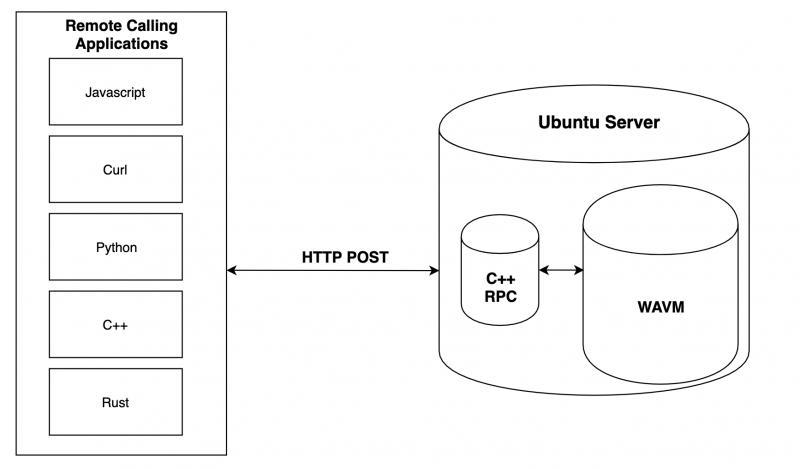去中心化计算的未来:通过RPC从微服务过渡到WASM
从浏览器内的角度来看,Wasm 最近的开发工作,理所当然地受到了广泛好评。在上一篇文章 《只需5分钟,教你如何编写并执行一个 Rust + WebAssembly 程序》 ,我们对 Rust 到 Wasm 的编译以及简单的浏览器内 Wasm 执行的案例做了演示。
在另外一篇文章 《区块链、硬件与面向服务的架构,WASM 即将迎来大爆发?》 ,里面有绝佳的浏览器内的 WASM 应用程序示例,并辅以了对WebAssembly(Wasm)的详细解释。
浏览器之外
Wasm 不仅仅是浏览器的字节码。 Wasm 有着前所未有的强大的可移植性、高效率和灵活性。因此,我们现在可以做到,以多种不同语言编写浏览器内 Wasm 应用程序,发展到在所有设备上分发 Wasm 独立功能单元,在这一点上取得飞跃。
Wasm 执行环境可以包括最少的 shell、移动设备、台式机和物联网设备。Wasm 可能会推动从微芯片乃至整个数据中心,这所有一切的发展(Webassembly.org,2019)。

为什么跨越浏览器很重要?
当连接到现代 Web 服务时,我们并非仅仅与一台机器进行交互,而是持续和后台可能数千台机器进行交互( Arpaci-Dusseau 和Arpaci-Dusseau,2018 )。
网站越复杂,运营成本就越高。散布在分布式系统上的微服务需要尽最大可能做到简单、高效和可靠。对于 Facebook、Google 这种大公司来说,这些特性意味着可以节省大量能耗,进而节省成本,促成积极成果。
除了这些能轻易做到的,我们还应该积极试验,以找到方法来改善 Wasm 最终用户/消费者体验。 eBay 就是一个很好的例子。
利用 Wasm,eBay 最近很好地完善了其移动条形码扫描仪的实现,恰到好处地为客户提供了最优服务( Tech.ebayinc.com,2019)。
为什么选 Wasm?
首先我们需要了解下“抽象化”。
虽然操作系统抽象化对于构建分布式系统来说是一个糟糕的选择,但编程语言抽象化却更具意义。 (阿帕奇-杜索和阿帕奇-杜索,2018)。Wasm 作为从一开始就使用形式语义设计的第一种主流编程语言,进一步地提供了对现代硬件的抽象化的支持(Rossberg等,2018)。
Wasm 允许在最大量的源代码语言中编写和共享每个单个功能的逻辑。Wasm符合我们熟知的最佳软件原则和惯例(DRY 和 KISS),并提供了必要时在所有设备之间转换可执行代码的方法。
为什么要进行远程过程调用(Remote Procedure Call)?
从进程间通信(IPC)角度来看,最主要的抽象化是基于远程程序调用(Remote Procedure Call)的概念,简称 RPC。(Arpaci-Dusseau和Arpaci-Dusseau,2018)。
要实现这种分布式机器之间普遍存在的互操作性,需要具备允许任何应用程序(以任何语言编写)直接从任何其他分布式机器调用服务的功能,就好像它只是调用自己的本地对象一样。 这正是远程过程调用 (RPC) 技术所实现的。
本文的目标是使用 Wasm 和 RPC 在 web 上执行与语言无关的通用代码。
在下一节中,会讲解如何:
- 编写自定义的 Rust 代码并编译为 Wasm
- 设置 RPC 服务器
- 在 RPC 服务器上定义自定义服务
- 安装 Wasm 虚拟机(WAVM)
- 通过 HTTP Post(即Curl,Python等)远程执行自定义 WebAssembly(Wasm)代码

1.编写自定义的 Rust 代码并编译为 Wasm
安装 Rust
curl --proto '=https' --tlsv1.2 -sSf https://sh.rustup.rs (https://sh.rustup.rs/) | shsource $HOME/.cargo/env
创建新的 Rust 项目
cd ~ cargo new --lib add_numbers_via_wavm cd add_numbers_via_wavm
编辑 Cargo.toml 文件; 添加 lib 部分 ,同时也添加依赖项,如下所示
[lib] name = "adding_lib" path = "src/adding.rs" crate-type =["cdylib"][dependencies] serde_json = "1.0"
在命令行中添加必要的 Wasm 软件和配置
rustup target add wasm32-wasi rustup override set nightly
创建一个名为 ~/.cargo/config 的新文件。并将以下构建文本放入这个新创建的配置文件中。
[build] target = "wasm32-wasi"
编写一个我们可以调用的有不同的功能的定制的 Rust 程序。
在下面的例子中,函数“ double”和“ triple” 会分别取一个整数并分别乘以 2 和 3。
use serde_json::json;
pub extern fn print(answer: i32){
let the_answer = json!({
"Result": answer});
println!("{}", the_answer.to_string());
}
#[no_mangle]
pub extern fn double(x: i32){
let z = x * 2;
print(z);
}
#[no_mangle]
pub extern fn triple(x: i32){
let z = x * 3;
print(z);
}
可以使用以下命令编译上面的代码
cargo build --release
2. 设置 RPC 服务器
这里给大家推荐一个简洁的 C++ RPC 服务器,叫做 [rpcsrv] ( https://github.com/jgarzik/rp... 。 我们要使用这个 C++ RPC 服务器来接受 HTTP POST 并通过 C++ 将它们转换为系统调用。
sudo apt-get update sudo apt-get -y upgrade sudo apt-get install autoconf sudo apt install libevent-2.1-6 sudo apt-get install libevent-dev sudo apt-get install libtool cd ~ git clone https://github.com/jgarzik/rpcsrv.git cd ~/rpcsrv git submodule update --init ./autogen.sh ./configure make sudo make install
使用以下命令开启 RPC 服务
sudo ./rpcsrvd --listen-port 8080
3. 在 RPC 服务器上定义自定义服务
在我们进一步讨论之前,我想简单地讨论一下 JSON 的使用。 我简要地探索了一个关于 单值 的绝妙概念。 Univalue 是一个高性能的 RAII C++ JSON 库和通用值对象类。我之后会找时间针对这个做彻底的研究。
方便起见,我结合使用了 UniValue 和 rapidjson 。 同样,我也需要更多的时间来研究,来找到数据交换和互操作性的最佳方法,我们之后再进行讨论。
下面的代码用于安装 rapidjson 。
cd ~ https://github.com/Tencent/rapidjson.git cd ~/rapidjson git submodule update --init mkdir build cd ~/rapidjson/build/ cmake .. sudo cp -rp ~/rapidjson/include/rapidjson /usr/include/
在安装 rapidjson 之后,我修改了原始 C++ API 文件,以便在 rpcsrvcodebase 中包含 rapidjson 功能。
#include "rapidjson/document.h" #include "rapidjson/writer.h" #include "rapidjson/stringbuffer.h" #include <iostream> using namespace rapidjson;
在这个阶段,我们可以继续在 C++ 代码中使用 rapidjson 功能。 下面是一个示例,演示如何修改 原始 echo 函数
//
// RPC "echo"
//
static UniValue myapi_1_echo(const UniValue & jreq,
const UniValue & params) {
// Receive and parse incoming parameters
string s = params.write();
const char * theJson = s.c_str();
Document d;
d.Parse(theJson);
// Assign parameters to C++ variables and print to console
Value & theService = d["Service Name"];
Value & theType = d["Type"];
Value & theFunctionName = d["Execution"]["FunctionName"];
Value & theArgument = d["Execution"]["Argument"];
cout << endl;
cout << "Received a new request to execute a service on Wasm Virtual
Machine..." << endl;
cout << s.c_str() << endl;
cout << endl;
cout << "Service Name is: " << theService.GetString() << endl;
cout << "Service Type is: " << theType.GetString() << endl;
cout << "Wasm function is: " << theFunctionName.GetString() << endl;
cout << "Wasm function argument: " << theArgument.GetString() <<
endl;
// Construct and execute the call to Wasm Virtual Machine
string commandString = "wavm run --abi=wasi --function=";
commandString += theFunctionName.GetString();
commandString += " ";
commandString += "~/add_numbers_via_wavm/target/wasm32
wasi / release / adding_lib.wasm ";
commandString += " ";
commandString += theArgument.GetString();
cout << "/n";
cout << "Executing command ... " << endl;
string theWasmResults =
execute_function_and_return_output(commandString);
// Print the result to console
cout << "Results are as follows ...: " << endl;
cout << theWasmResults << endl;
UniValue result(theWasmResults);
cout << "Finished." << endl;
// Return the results back to the caller of the RPC
return jrpcOk(jreq, result);
}
4. 安装Wasm 虚拟机(WAVM)
WAVM 使用 LLVM 将 WebAssembly 代码编译成机器代码,其性能接近原生性能。
下面是安装 WAVM的说明
sudo apt-get install gcc sudo apt-get install clang wget https://github.com/WAVM/WAVM/releases/download/nightly%2F2019-11-04/wavm-0.0.0-prerelease-linux.deb sudo apt install ./wavm-0.0.0-prerelease-linux.deb
5. 通过 HTTP Post (即 Curl、 Python 等)远程执行自定义 WebAssembly (Wasm) 代码
执行可以由任何能够生成 HTTP POST 的机制执行。 例如,从 Postman 这样的 GUI 到 Linux curl 命令,当然还有像 Python 和 Java 这样的解释和编译代码库。
下面是在 linux 命令行中使用 Curl 的调用代码示例
Curl - 传入一段有效的JSON代码
tpmccallum$ curl --header "Content-Type: application/json" --request POST --data '{"jsonrpc":"2.0","method":"echo","params":{"Service Name": "Double the digits","Type": "Execution","Execution": {"FunctionName": "double","Argument": "10"}}, "id":1}' [http://123.456.78.9:8080/rpc/1](http://localhost:8080/rpc/1)
当查看这个调用代码时,请记住 Rust 程序( Wasm 最早缘起于 Rust) 有两个函数: “ double”和“ triple”。 增加的 RPC 层意味着这些原始函数现在被定义为两个单独的服务。
正如上面所看到的,我们不仅要指定想调用的服务,还要指定所需的单个参数。 当这个 POST 在 web 上执行时,RPC 服务器直接调用 WAVM,然后返回一个 JSON 结果对象给调用代码。
返回有效的 JSON
{
"jsonrpc": "2.0",
"result": {
"Result": 20
},
"id": 1
}
返回对象是完全可配置的,这只是一个返回计算结果的简单示例。
RPC 服务器输出
RPC 服务器输出是可选的,这里只是为了演示而创建的。 这里演示了 RPC 服务器可以来回传递 JSON。其他格式也有机会内置到 RPC 层(位于 Rust 和 Wasm 代码之上)。
Received a new request to execute a service on Wasm Virtual Machine... {"Service Name":"Double the digits","Type":"Execution","Execution":{"FunctionName":"double","Argument":"10"}}Service Name is: Double the digits
Service Type is: Execution
Wasm function is: double
Wasm function argument: 10Executing command ...Results are as follows ...:
{"Result":20}Finished.
Python - 传入一段有效的JSON代码
系统设置
sudo apt-get install python-pip pip install json-rpc pip install requests
我们将 Python 传入一段有效的JSON代码,描述我们需要哪种服务。 在这个例子中,我们希望将数字10翻一倍,即调用“ FunctionName” : “ double”和“ Argument” : “10”。
>>>import requests
>>>import json
>>>url = "http://123.456.78.9:8080/rpc/1"
>>>payload = {
"jsonrpc":"2.0","method":"echo","params":{"Service Name":"Double the digits","Type": "Execution","Execution": {"FunctionName": "double","Argument": "10"}}, "id":1
}
>>>response = requests.post(url, json=payload).json()
现在我们可以看到,响应返回执行 Wasm 的结果,即“ Result” : 20。
>>> print response{u'jsonrpc': u'2.0', u'result': u'{"Result":20}, u'id': 1}
我们可以通过调用另一个服务(即“ FunctionName” : “ triple” ,“ Argument” : “10”)再次尝试这个方法
>>>url = "http://123.456.78.9:8080/rpc/1"
>>>payload = {
"jsonrpc":"2.0","method":"echo","params":{"Service Name":"Triple the digits","Type": "Execution","Execution": {"FunctionName": "triple","Argument": "10"}}, "id":1
}
>>>response = requests.post(url, json=payload).json()
同样,我们可以看到这个响应是所选服务的正确结果。
>>> print response
{u'jsonrpc': u'2.0', u'result': u'{"Result":30}', u'id': 1}
本文通过 RPC 演示了如何使用 Wasm 。我是一名热情的开源区块链软件研究人员,也是 SecondState 公司(在达拉斯、奥斯汀、北京和台北设有办公室)的核心开发 https://www.SecondState.io/ 。 如果你想了解更多关于 Wasm 和其他可以提升业务的技术,请通过 电子邮件 或 [GitHub] ( https://github.com/second-sta... 与我们联系。
参考文献
- Arpaci-Dusseau, R.H. 和 Arpaci-Dusseau, A.C.,2018, 《操作系统:三个简单的部分》, Arpaci-Dusseau Books LLC.
- Rossberg, A., Titzer, B., Haas, A., Schuff, D., Gohman, D., Wagner, L., Zakai, A., Bastien, J. 以及 Holman, M. (2018), 《使用 WebAssembly 加速网络发展》, ACM通讯,107-115页.
- Tech.ebayinc.com. (2019), eBay 上的 WebAssembly : 一个真实世界的案例, [在线资源] 可访问: https://tech.ebayinc.com/engi... [2019年11月20日访问].
- 本文标签: 服务器 https 配置 GitHub value 文章 分布式 web git 安装 Google ebay 开源 python id wget struct 网站 API json 开发 ACE 希望 update ip cat 移动设备 Document 操作系统 http IO 2019 java shell 进程 Facebook parse dependencies 运营 Service stream linux remote tar IDE App 参数 src 物联网 微服务 定制 数据 时间 软件 lib 系统设置 字节码 编译 js UI 代码 list build IOS 分布式系统
- 版权声明: 本文为互联网转载文章,出处已在文章中说明(部分除外)。如果侵权,请联系本站长删除,谢谢。
- 本文海报: 生成海报一 生成海报二











![[HBLOG]公众号](https://www.liuhaihua.cn/img/qrcode_gzh.jpg)

